Oven-roasted stuffed guinea fowl with chestnuts is a dish that immediately evokes the culinary tradition of Lombardy, a symphony of autumn flavors that perfectly matches the conviviality of the holidays. Imagine the table set, the inviting aroma wafting from the kitchen, the warmth of the home hearth: the guinea fowl, queen of the feast, makes its triumphant entrance, golden and crispy, with a rich and flavorful stuffing that encapsulates all the generosity of our land.
In Lombardy, the guinea fowl has always been the star of Sunday lunches and special occasions. Once, it was customary to raise them in the yard, and its prized meat was reserved for festive days. Today, the tradition continues, and the stuffed guinea fowl, with its rich and flavorful filling, represents a true symbol of conviviality and abundance.
The recipe we offer is a tribute to the Lombard tradition, with a touch of originality. The stuffing, made of ground pork, sausage, prosciutto, chestnuts, and pistachios, is an explosion of flavors that blend harmoniously with the delicate guinea fowl meat. The potatoes, roasted alongside the bird, complete the dish with their rusticity, while the aroma of rosemary and sage transports us to an atmosphere of festivity and home.
This stuffed guinea fowl is a complete and versatile dish, which can be served as a main course, accompanied by seasonal sides, or as a single dish, for a rich and substantial meal. And to conclude in style, don’t forget the typical Lombard desserts, such as panettone and nougat, for a Christmas full of taste and conviviality.
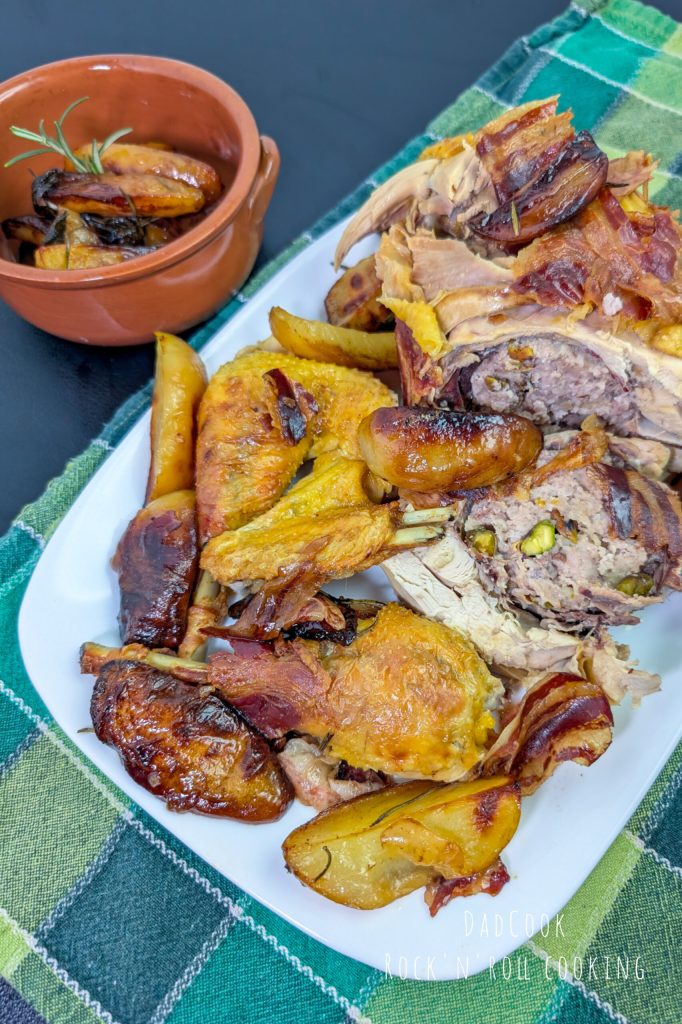
- Difficulty: Very Easy
- Cost: Economical
- Rest time: 30 Minutes
- Preparation time: 50 Minutes
- Portions: 6
- Cooking methods: Oven, Electric Oven
- Cuisine: Italian
- Seasonality: Christmas, New Year's Eve
- Energy 360.97 (Kcal)
- Carbohydrates 13.68 (g) of which sugars 1.21 (g)
- Proteins 28.33 (g)
- Fat 21.20 (g) of which saturated 4.55 (g)of which unsaturated 9.07 (g)
- Fibers 2.00 (g)
- Sodium 679.66 (mg)
Indicative values for a portion of 260 g processed in an automated way starting from the nutritional information available on the CREA* and FoodData Central** databases. It is not food and / or nutritional advice.
* CREATES Food and Nutrition Research Center: https://www.crea.gov.it/alimenti-e-nutrizione https://www.alimentinutrizione.it ** U.S. Department of Agriculture, Agricultural Research Service. FoodData Central, 2019. https://fdc.nal.usda.gov
Ingredients
- 3.3 lbs guinea fowl (Whole)
- 5.3 oz ground pork
- 5.3 oz sausage
- 3.5 oz prosciutto
- 7.1 oz pancetta
- 1 oz grated Parmesan
- 1 egg
- 2 tbsp milk (Optional)
- 15 boiled chestnuts
- 1 handful pistachios
- to taste nutmeg
- 28.2 oz potatoes
- 2 sprigs rosemary
- A few leaves sage
- 1 clove garlic
- to taste extra virgin olive oil
- to taste salt
- 1 pinch black pepper
- Half glass dry white wine
Tools
- 1 Baking Pan
- 1 Bowl
Steps
Let’s start with the first step of our recipe for stuffed guinea fowl! Take the handful of pistachios and shell them one by one. Once shelled, place them in a non-stick pan and toast them over medium heat for about a minute, stirring often to prevent burning.
This toasting is essential to enhance their aroma, make them crunchier, and facilitate digestion. Once toasted, let them cool completely before adding them to the stuffing. And now, let’s proceed to the next step!

Ready for the second step, where we will create a simple but tasty stuffing, perfect for enhancing the flavor of our guinea fowl?
I chose these ingredients because each one contributes to creating a balance of flavors and textures. The ground pork adds softness, the sausage a bold taste, the boiled chestnuts a delicate sweetness, and the toasted pistachios a pleasant crunch. The nutmeg, finally, adds an aromatic touch that binds all the ingredients.
Take a large bowl and put the ground pork, crumbled sausage, nutmeg, salt, black pepper, hand-crushed boiled chestnuts, and the toasted pistachios we prepared earlier.
Now that we’ve gathered our base ingredients, we can move on to the next phase!

And now, let’s enrich our stuffing with other ingredients that will add even more flavor and texture! We add finely chopped prosciutto — this will give the stuffing an intense aroma and a pleasant savoriness — an egg, which will serve as a binder, and a generous handful of grated cheese, for an extra touch of flavor and a stringy texture.
Mix everything with your hands, working the mixture until it is well combined and homogeneous.
Cover the bowl with plastic wrap and let the stuffing rest in the fridge for at least 30 minutes: this will allow the flavors to meld perfectly.
Meanwhile, let’s focus on cleaning the guinea fowl, a crucial step for the success of our dish!

Now take the whole guinea fowl and with a sharp knife, remove the head, neck, and legs: for this recipe, we’ll only need the torso.
Clean it thoroughly both inside and out, removing any feather residues or viscera. With a damp paper towel, clean the guinea fowl well both inside and out, then dry it carefully with kitchen paper.
Now we are ready to stuff it! Gently fill the guinea fowl’s cavity with our stuffing, being careful not to compress it too much to avoid it spilling out during cooking. Once stuffed, close the opening with kitchen twine and a needle, or if you prefer, with toothpicks.The important thing is that it’s well closed to prevent the stuffing from spilling out during baking.

And here we are at the moment of preparing our guinea fowl for baking! Take a large baking tray and line it with parchment paper: this will help keep the tray clean and make final cleaning easier.
Now, create a base with the thinly sliced pancetta: this layer of pancetta will not only flavor the guinea fowl but also protect it from the direct heat of the oven, preventing it from drying out too much during cooking.
Place the guinea fowl on top of the pancetta base and cover it entirely with the remaining slices, as if you were wrapping it in a soft blanket. This trick will keep it moist and succulent, preventing the meat from drying out.
Arrange the potatoes cut into wedges or cubes around the guinea fowl, forming a tasty and colorful side. Season the potatoes with a pinch of salt, a drizzle of extra virgin olive oil, and the spices you prefer: rosemary, sage, garlic… Let your imagination run wild and create your favorite combination of aromas!
Now, we just have to bake our guinea fowl and wait for it to transform into a masterpiece of taste!
And here is our oven-roasted stuffed guinea fowl with chestnuts, perfectly cooked and ready to be enjoyed!
Let it cool slightly before slicing, so the juices redistribute inside the meat, making it even more flavorful.
With a sharp knife, cut the guinea fowl into portions, taking care to divide the stuffing equitably among the diners. Serve it on a serving platter, accompanied by the roasted potatoes that have absorbed all the cooking aromas.
For an extra touch of elegance, we can garnish the dish with a few sprigs of fresh rosemary.
This stuffed guinea fowl is a rich and tasty dish, perfect for special occasions and holidays. The flavorful stuffing, tender meat, and aromatic potatoes will win over all your guests’ palates!
Enjoy your meal!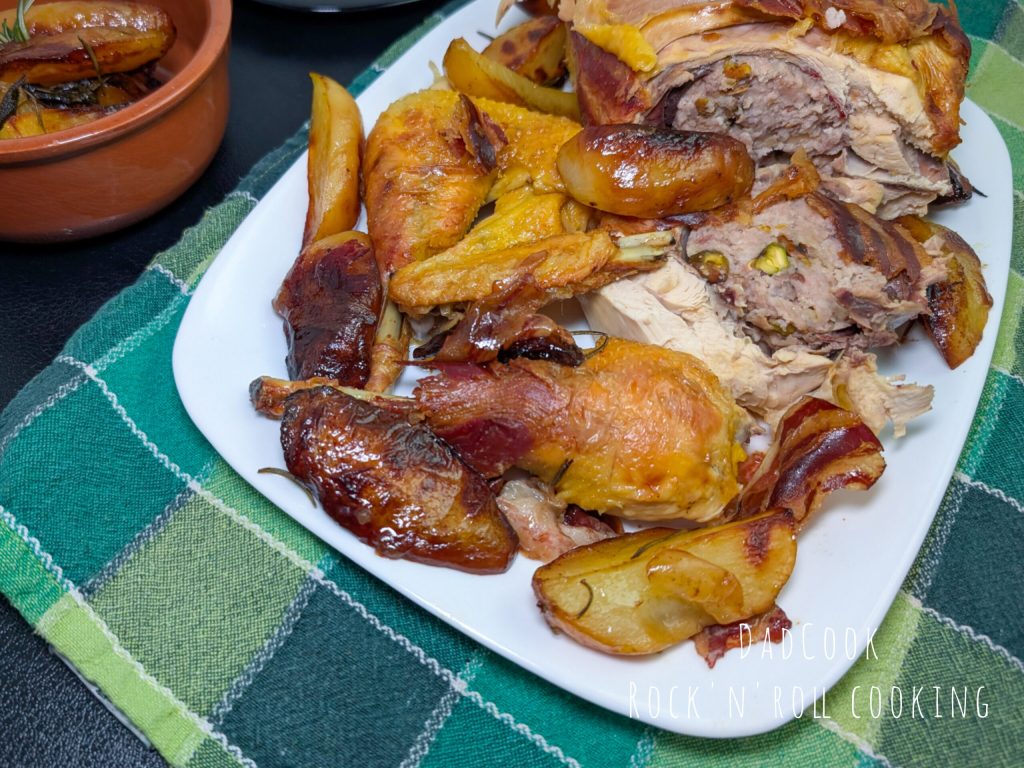
Here are some tips, variations, and suggestions for storing your oven-roasted stuffed guinea fowl with chestnuts:
Tips:
Choose quality guinea fowl: Opt for a free-range guinea fowl, raised on the ground; its meat will be more flavorful and tender.
Don’t overfill the stuffing: Fill the guinea fowl without compressing it excessively, to prevent it from breaking during cooking.
Check the cooking: Use a kitchen thermometer to check the internal temperature of the guinea fowl. The core temperature of the thigh should reach 165°F.
Let the meat rest: Before slicing the guinea fowl, let it rest for at least 15 minutes out of the oven. This will allow the juices to redistribute, making the meat more tender and juicy.
Pair with sauces: Serve the guinea fowl with sauces of your choice, such as a berry sauce or a fruit mustard.
Variations:
Vegetarian stuffing: Replace the ground meat and sausage with a mix of vegetables, such as mushrooms, carrots, zucchini, and spinach.
Dried fruit: Enrich the stuffing with other dried fruits, such as walnuts, hazelnuts, or almonds.
Aromas: Experiment with different herbs, such as thyme, marjoram, or bay leaf, to personalize the flavor of the guinea fowl.
Wine: Deglaze the guinea fowl with dry white wine or Marsala during cooking, for a more intense aroma.
Storage:
In the fridge: Cooked stuffed guinea fowl keeps in the fridge for 2-3 days, in an airtight container.
In the freezer:
You can freeze cooked stuffed guinea fowl, already portioned, for up to 2 months.
Thaw it in the fridge before consuming.
Reheating: Reheat the guinea fowl in the oven at 355°F for about 15 minutes, or in a pan with a little oil.
I hope these tips will be useful to you!
Enjoy your meal! 😋
Wine to pair with oven-roasted stuffed guinea fowl with chestnuts:
Oven-roasted stuffed guinea fowl with chestnuts requires a wine that can balance its richness of flavors and sweetness tendency.
Here are 5 wines perfect for pairing:
Reds:
Nebbiolo: An elegant Piedmont red, with soft tannins and notes of red fruits and spices, perfect to accompany the complexity of the stuffing.
Pinot Noir from Oltrepò Pavese: A well-structured Lombard wine, with aromas of cherry and underbrush, that pairs well with the delicacy of guinea fowl meat.
Schiava (Vernatsch): A light and fruity South Tyrolean wine, with a slight acidic note that balances the sweet tendency of chestnuts.
Whites:
Gewürztraminer: An aromatic Alsatian white, with notes of exotic fruits and spices, ideal for enhancing the flavors of the stuffing. Verdicchio dei Castelli di Jesi: A structured Marche white, with hints of yellow fruit and almond, which pairs well with the savoriness of the meat.
FAQ (Questions and Answers)
What is guinea fowl?
Guinea fowl is a bird similar to chicken, but with more flavorful and slightly darker meat. It has a delicate taste, reminiscent of pheasant, and is perfect for oven roasting.
How do you clean the guinea fowl before cooking?
Remove any remaining feathers, empty the internal cavity, and remove the viscera. Dab the guinea fowl with a damp paper towel, both inside and out, to remove any impurities. Dry it well before proceeding with the recipe.
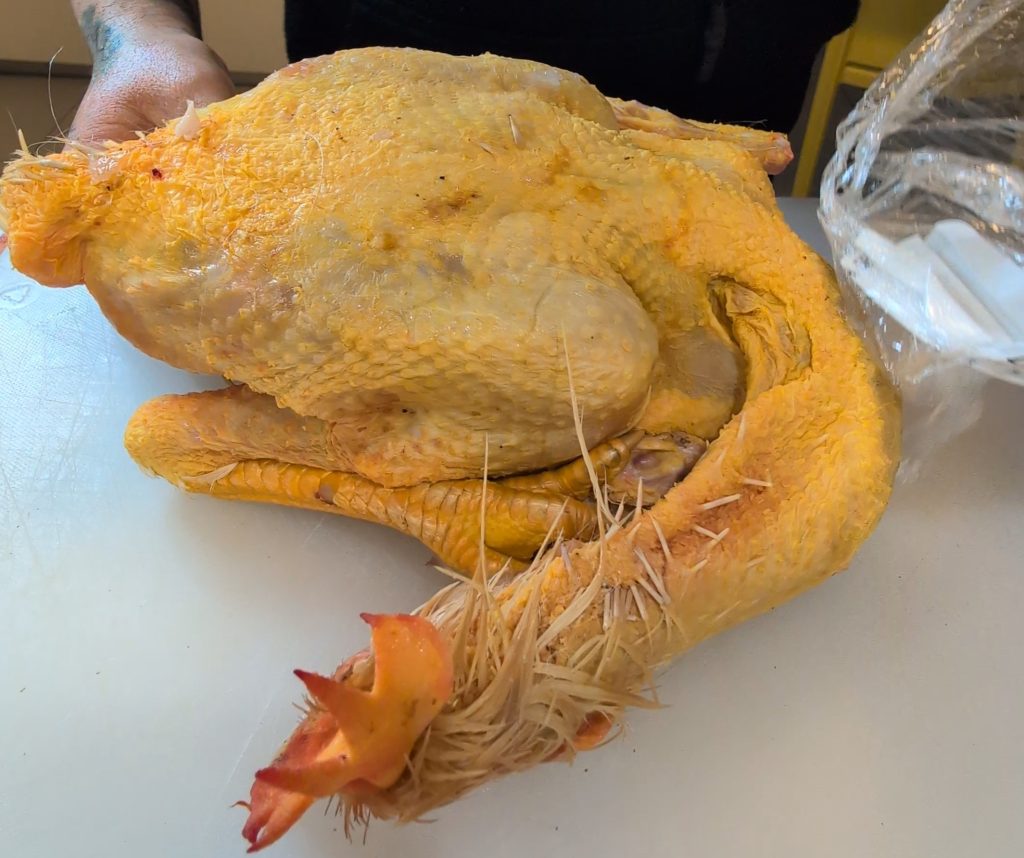
How do you prevent guinea fowl from drying out in the oven?
To prevent the meat from drying out during cooking, you can use several methods:
Pancetta wrapping: Cover the guinea fowl with slices of pancetta or lard, which will protect it from direct heat and keep it moist.
Low-temperature cooking: Cook the guinea fowl at a lower temperature (320-356°F) for a longer time. Adding liquids: Add broth or wine to the pan during cooking, to create moisture and prevent the meat from drying out.
How long does it take to cook guinea fowl in the oven?
The cooking time varies depending on the size of the guinea fowl and the oven temperature. Generally, for a guinea fowl of about 3.3 lbs, it takes about 1 hour and 30 minutes at 356°F. How do you know if the guinea fowl is cooked? Use a kitchen thermometer. Insert the probe into the thickest part of the thigh, without touching the bone. The internal temperature should reach 165°F.
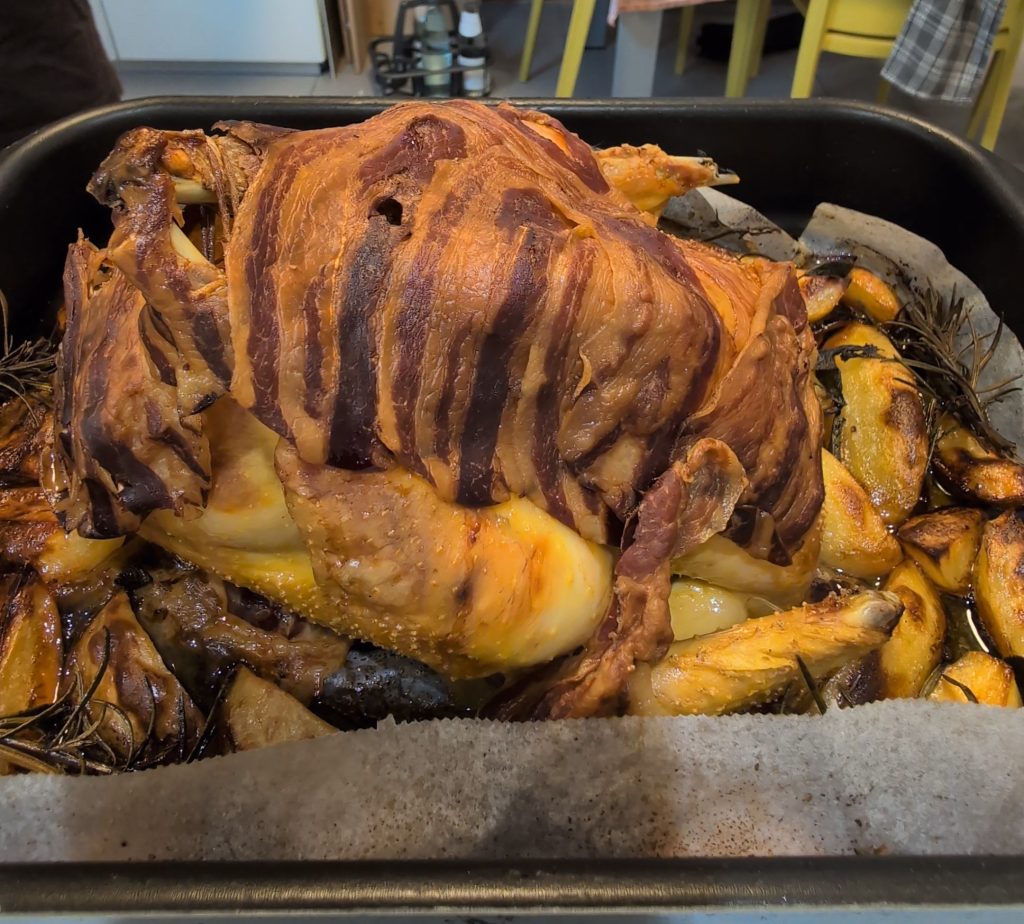
How do you know if the guinea fowl is cooked?
Use a kitchen thermometer to verify the cooking. Insert the probe into the thickest part of the thigh, without touching the bone. The internal temperature should reach 165°F.
What are the best side dishes for oven-roasted guinea fowl?
Oven-roasted guinea fowl pairs well with various side dishes, such as:
Roasted potatoes: A timeless classic, roasted potatoes perfectly complement the flavor of guinea fowl.
Seasonal vegetables: Pumpkin, carrots, broccoli, cauliflower… choose your favorite vegetables and roast them alongside the guinea fowl or separately.
Salad: A fresh and light salad is ideal to balance the richness of the guinea fowl.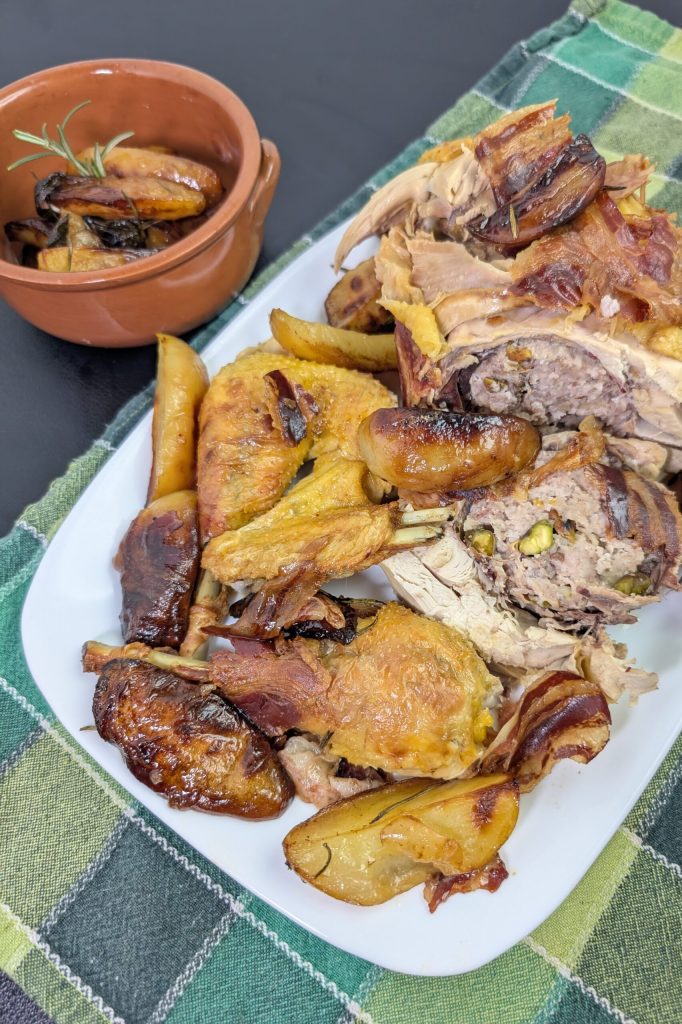
Can I stuff the guinea fowl?
Absolutely! Guinea fowl is great for stuffing. You can use a stuffing made of ground meat, sausage, chestnuts, dried fruits, herbs… Get creative with your imagination!

How do you store cooked guinea fowl?
Cooked guinea fowl keeps in the fridge for 2-3 days, in an airtight container. You can also freeze it, already portioned, for up to 2 months.
How do you reheat cooked guinea fowl?
Reheat the guinea fowl in the oven at 355°F for about 15 minutes, or in a pan with a little oil, until it is thoroughly heated.
Is guinea fowl a healthy meat?
Yes, guinea fowl is a lean meat rich in protein, with a low fat content. It is a good source of B vitamins and minerals like iron and zinc.
Where can I find more recipes with guinea fowl?
On the web and in cookbooks, you can find plenty of recipes with guinea fowl, from classic roasts to more elaborate preparations. Experiment and discover the one that suits you!

